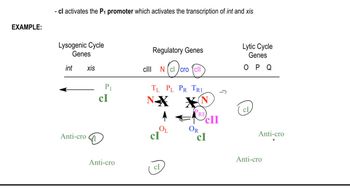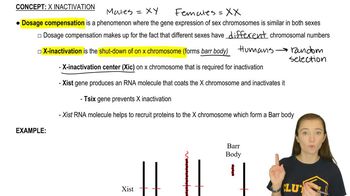Table of contents
- 1. Introduction to Genetics51m
- 2. Mendel's Laws of Inheritance3h 37m
- 3. Extensions to Mendelian Inheritance2h 41m
- 4. Genetic Mapping and Linkage2h 28m
- 5. Genetics of Bacteria and Viruses1h 21m
- 6. Chromosomal Variation1h 48m
- 7. DNA and Chromosome Structure56m
- 8. DNA Replication1h 10m
- 9. Mitosis and Meiosis1h 34m
- 10. Transcription1h 0m
- 11. Translation58m
- 12. Gene Regulation in Prokaryotes1h 19m
- 13. Gene Regulation in Eukaryotes44m
- 14. Genetic Control of Development44m
- 15. Genomes and Genomics1h 50m
- 16. Transposable Elements47m
- 17. Mutation, Repair, and Recombination1h 6m
- 18. Molecular Genetic Tools19m
- 19. Cancer Genetics29m
- 20. Quantitative Genetics1h 26m
- 21. Population Genetics50m
- 22. Evolutionary Genetics29m
12. Gene Regulation in Prokaryotes
Lambda Bacteriophage and Life Cycle Regulation
Problem 28f
Textbook Question
How would mutations that inactivate each of the following genes affect the determination of the lytic or lysogenic life cycle in mutated λ phage strains? Explain your answers. cI
 Verified step by step guidance
Verified step by step guidance1
Understand the role of the cI gene in the λ phage life cycle. The cI gene encodes the λ repressor protein, which is crucial for maintaining the lysogenic state by repressing the lytic genes.
Recognize that inactivation of the cI gene would lead to the absence of the λ repressor protein. Without this protein, the repression of lytic genes is lifted.
Consider the consequences of the absence of the λ repressor. The lytic genes, which are normally kept inactive in the lysogenic cycle, would become active.
Analyze the impact on the life cycle decision. With the lytic genes active, the phage would be more likely to enter the lytic cycle, leading to the production of new phage particles and the eventual lysis of the host cell.
Conclude that a mutation inactivating the cI gene would likely shift the balance towards the lytic cycle, as the repression of lytic genes is a key factor in maintaining lysogeny.
Recommended similar problem, with video answer:
 Verified Solution
Verified SolutionThis video solution was recommended by our tutors as helpful for the problem above
Video duration:
2mPlay a video:
Was this helpful?
Key Concepts
Here are the essential concepts you must grasp in order to answer the question correctly.
Lytic and Lysogenic Cycles
The lytic and lysogenic cycles are two distinct pathways that bacteriophages, like λ phage, can follow after infecting a host bacterium. In the lytic cycle, the phage replicates rapidly, leading to the destruction of the host cell and the release of new phage particles. In contrast, the lysogenic cycle involves the integration of the phage DNA into the host genome, allowing it to replicate along with the host cell without causing immediate harm.
Recommended video:
Guided course

Decision Between Lytic and Lysogenic Cycles
cI Gene Function
The cI gene in λ phage encodes a repressor protein that is crucial for maintaining the lysogenic state. This protein binds to the operator region of the phage genome, preventing the expression of genes necessary for the lytic cycle. When the cI gene is inactivated by mutations, the repression is lifted, potentially triggering the phage to enter the lytic cycle instead of remaining dormant.
Recommended video:
Guided course

Functional Genomics
Mutations and Gene Inactivation
Mutations are changes in the DNA sequence that can lead to the inactivation of genes, affecting their normal function. In the context of the cI gene, mutations that disrupt its coding sequence can prevent the synthesis of the repressor protein, thereby altering the balance between the lytic and lysogenic cycles. Understanding how specific mutations impact gene function is essential for predicting the behavior of phage strains in response to genetic changes.
Recommended video:
Guided course

X-Inactivation

 4:29m
4:29mWatch next
Master Bacteriophage Life Cycle with a bite sized video explanation from Kylia Goodner
Start learning


